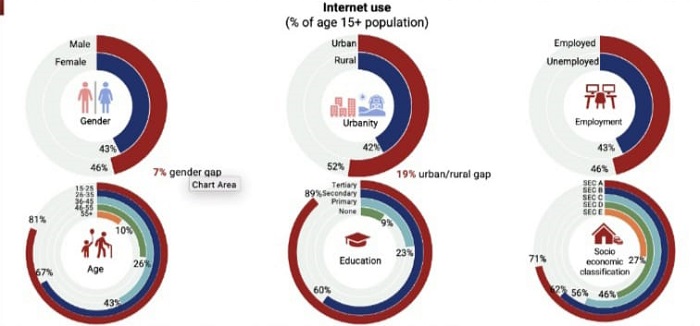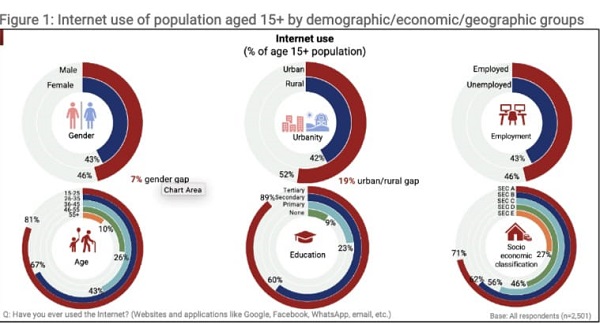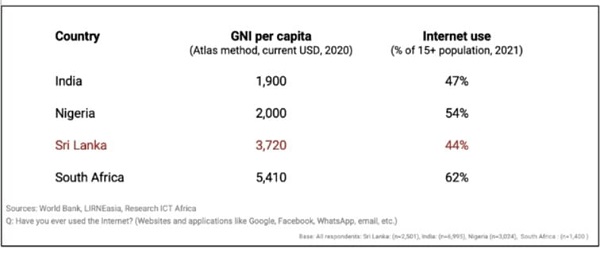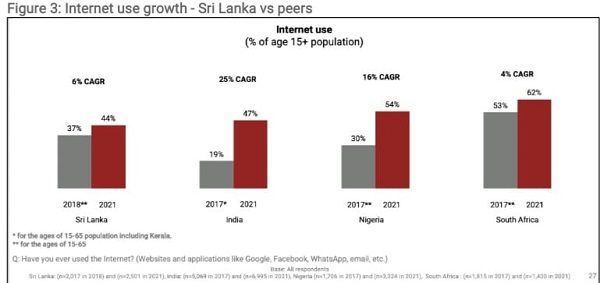
A recent national survey conducted by LIRNEasia, a regional policy think tank, showed that 44% of Sri Lanka’s population aged 15 and above were internet users in 2021. Internet use was lower amongst the rural, elderly, less educated and poorer groups. Those residing in rural areas, for example, were 19% less likely to be online than their peers residing in urban areas (Figure 1).

The pandemic situation has brought many online, with 31% of new users (aged 15 and above) in 2020 and 2021 citing that they came online due to a need brought about by the pandemic. Despite the growth experienced, internet use levels in Sri Lanka this year were below that of countries such as India and Nigeria. Sri Lanka’s sub-par performance in this regard is notable for two reasons. First, because empirical evidence shows that countries with higher per capita income often have higher internet use levels. Sri Lanka’s internet use levels were below that of countries with lower per capita income levels (Figure 2). Second, because Sri Lanka has out-performed these countries in the past, but recent high growth in countries such as India — where internet use grew by 25% annually — have led to them overtaking Sri Lanka (Figure 3).
Figure 2: Internet use and GNI per capita – Sri Lanka vs peers

Figure 3: Internet use growth – Sri Lanka vs peers

“Concerted efforts should be made to bring and keep those at the margins online,” Senior Research Manager, Gayani Hurulle of LIRNEasia, stated. “These include ensuring that high-quality, affordable internet is available to all, and digital skills of users are built to allow for productive, responsible and safe internet use.”
The survey findings were released at a virtual launch event conducted on 8 December 2021, which included a panel discussion with leading government, private sector and civil society representatives. Panelists included Oshada Senanayake (Director General, Telecommunications Regulatory Commission of Sri Lanka & Chairman, ICT Agency of Sri Lanka), L. Ilaangovan, Secretary of Education, Cultural Affairs, Sports and Youth Affairs of the Northern Provincial), Jiffry Zulfer (Founder and CEO, PickMe), Karin Fernando (Team Leader for Sustainable Development, CEPA) and Gayani Hurulle (Senior Research Manager, LIRNEasia). The discussion was moderated by Rohan Samarajiva (Chair, LIRNEasia).
About the research: The research was funded by the International Development Research Centre (IDRC) through a grant given to three regional think tanks, LIRNEasia, Research ICT Africa and Instituto de Estudios Peruanos. The nationally representative sample for the survey conducted in Sri Lanka consisted of 2,500 households and individuals across the country covering 125 Grama Niladhari Divisions. The sampling methodology has been designed to ensure representation of the target group (population aged 15+) at a national level with a +/-2.8% margin of error at a confidence level of 95-percent. The data also allows for disaggregation by urban/rural divide, gender and socio-economic classification at the national level, as well as by within and outside the Western Province.
About LIRNEasia: LIRNEasia is an Asia Pacific ICT policy and regulation think tank. Its mission is to catalyze policy change through research to improve people’s lives in the emerging Asia Pacific by facilitating their use of hard and soft infrastructures through the use of knowledge, information and technology. For more information see https://lirneasia.net/